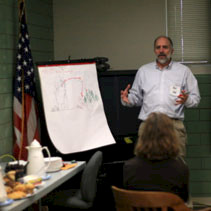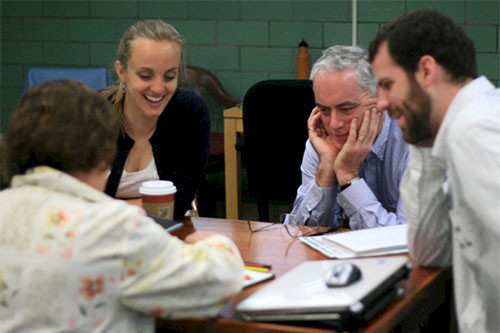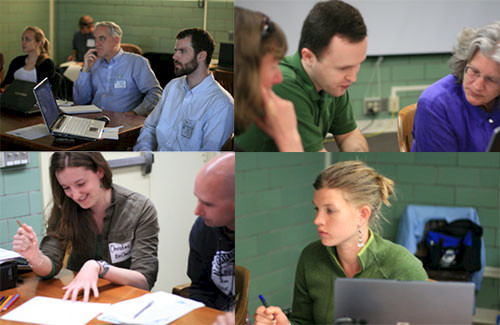Science Communication Course
Bill Dennison ·
A group of Integration and Application Network staff taught a one day science communication course at the Oxford Cooperative Laboratory on April 19. Bill Dennison, Jane Thomas, Jane Hawkey and Caroline Wicks covered the principles of science communication and provided lectures, activities, demonstrations and exercises for creating conceptual diagrams, PowerPoint presentations, and design/layout of posters and newsletters. Overall, there was a lot of material packed into the one day course. Three interactive course activities included: 1) Conceptionary, a game designed to expose people to creating conceptual diagrams, 2) Title Pursuit, a game designed to develop active titles—short declarative statements that summarize the issue being communicated, and 3) Storyboarding, a game designed to design a layout of integrating visual elements and text for printed communication products. Students downloaded IAN symbol libraries and had laptops with appropriate software to conduct exercises designed to expose them to the basic functions of science communication.

Students included Maryland Department of Natural Resources staff, NOAA staff, graduate students, representatives from citizen scientist groups, IAN interns and an IAN colleague from Ottawa, Canada (Dr. Bill Nuttle). This wide diversity of students and experienced scientists all benefited from improving their science communication skills. Heath Kelsey, a Science Integrator from EcoCheck based at the Oxford Cooperative Laboratory who hosted this course venue, was gracious enough to allow the class to use his PowerPoint lecture as an example for a group critique. This group critique is a constructive technique that IAN regularly employs to improve the quality of its science communication products. For the uninitiated, it can be disconcerting, because the critique can challenge virtually every aspect of a science communication draft, including titles, graphs used, and conclusions. The comments come so fast during a group critique that IAN staff have learned to nominate a note-taker, other than the person who’s work is being critiqued, in order to capture the constructive criticisms, so that the person being critiqued can have a follow up list of suggestions. The resulting final product is invariably improved and relative status or rank of the person being critiqued does not make anyone immune from valuable suggestions for improvement. Heath is presenting the critiqued talk two days following the course, at the IAN Seminar Series (see the website for video, audio, and text versions).

Science communication training in a group venue is a powerful way to obtain a feel for what a productive group dynamic can achieve. Both the creative process of generating science communication products and the group critique is highly collaborative. Now that the software has advanced to where individuals can pursue the development of graphics at desktop or laptop computers without professional graphic artists or mainframe computers, there is a danger of conducting these activities in isolation. The group dynamic that IAN staff use provides time for Science Communicators to work individually, but also provides for opportunities for the collaborative brain-storming needed for generating products and critiquing them. Since science communication is all about communicating, then the live, in person, verbal communication counts as much as written or web products. These interactions are important to building the message and the act of articulating your perspective can elicit a fairly good summary of the issue, as well as provide immediate feedback.
About the author
Bill Dennison

Dr. Bill Dennison is a Professor of Marine Science and Vice President for Science Application at the University of Maryland Center for Environmental Science.

